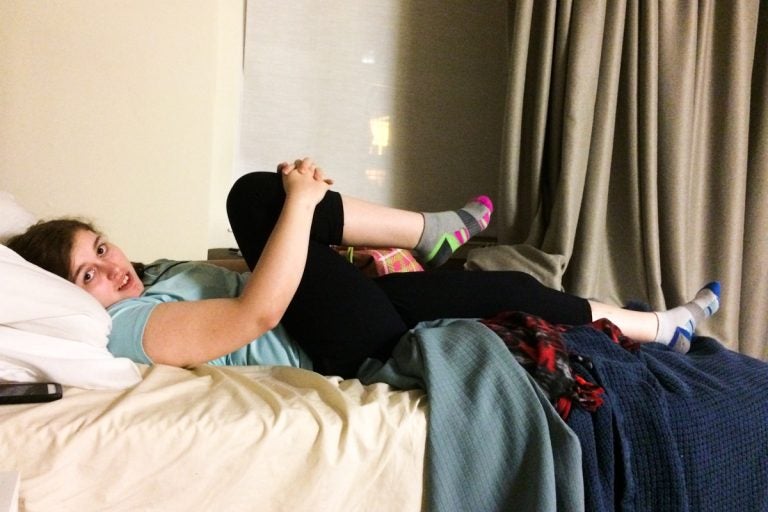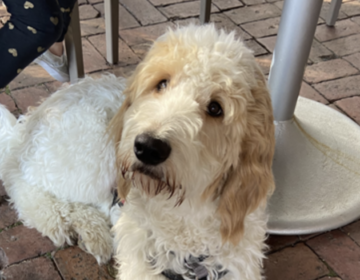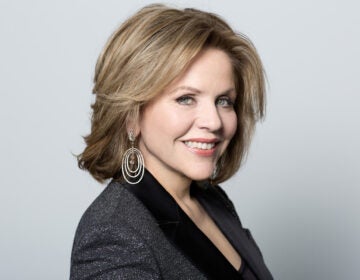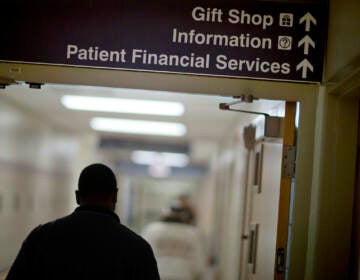For these teens, the only way to overcome pain is to face it
Savannah Fleeman, 17, has a rare pain syndrome and says even the lightest touch felt like “being stabbed.” A controversial therapy pushed her to feel that pain over and over.
Listen 10:57
Savannah Fleeman was diagnosed with a form of amplified musculoskeletal pain syndrome. Here she stretches during therapy (Courtesy of the Fleeman family)
For 17-year-old Savannah Fleeman, even the lightest touch to her skin was painful.
“It’s kind of hard to describe,” Fleeman said. “It was sort of like being stabbed.”
For Mary Kelly Shevlin, who’s also 17, even the softest breeze, especially on her feet, could feel like a blow torch.
“It’s almost like you had a really awful bruise or a really awful burn, but just your entire body is that,” Shevlin said. “And so everything that touches you —like clothes, sheets, anything like that, water — it shouldn’t hurt, and you know it shouldn’t hurt, but it does.”
Shevlin says by high school the pain consumed her.
“It started to travel to my back and my hips, and it got a lot harder for me to push through it,” she said.
The pain worsened for Fleeman, too, and went beyond the boundaries of some other health conditions she had. At times, it put her in a wheelchair.
“A lot of times people would come up and ask, ‘Why are you in a wheelchair? What’s wrong with you?’ And it’s hard to answer that because it’s like people are questioning something that you have been dealing with for so long and can’t help,” Fleeman said. “And it makes you feel like it’s not validated that you’re hurting, or that it’s fake because they can’t see it.”
After years of unknowns, both Shevlin and Fleeman were finally diagnosed with a form of amplified musculoskeletal pain syndrome or AMPS. Many also call the pain condition complex regional pain syndrome or CRPS.
AMPS is a rare condition and is often misdiagnosed. The exact cause and trigger of the pain isn’t clear. Research is ongoing, but experts suspect genetics play a role, in combination with psychological stressors. The condition is not limited to young people, but AMPS affects women more than men. The condition can also surface and flare up after a trivial injury, like a sprain from playing sports.
One controversial approach to treating AMPS or CRPS involves facing the pain head on — along with all the fears that come with it.
Retraining the brain
“You override the pain signals to reset them, and you do that by stimulating the pain over and over and over until it settles down and resets,” said rheumotologist David Sherry, founder and director of the Center for Amplified Musculoskelatal Pain Syndrome at the Children’s Hospital of Philadelphia.

Sherry has been studying AMPS for decades. He says AMPS is different from other types of chronic and acute pain, such as a bone break. In this case the pain takes on a life of its own, Sherry says, so a pain pill or a traditional medical intervention don’t work.
He first learned about AMPS as a medical student in Texas. Later, as a rheumatologist in training in British Columbia, he encountered more patients like this. Many would also have a cold, blue hand or foot — a classic symptom of one form of AMPS — that was so painful for the kids that they couldn’t walk on it, put weight on it, or allow anything to touch it.
Sherry and other physicians offered patients physical therapy and medications such as nerve blockers. In some instances that would help, but only for a short period of time. It was perplexing to him that none of it seemed to really work. Sherry and others wondered what else might have been going on, psychologically, with the patients, too.
“We didn’t really help a lot of these kids. It really wasn’t what I liked,” Sherry said. “It was kind of a mystery.”
In the late 1970s he took a job at the Childrens Hospital of Los Angeles, where clinicians had a different approach. There, Sherry recalled, they didn’t use drugs for the pain or the nerves. Instead, they focused on intensive physical therapy.
“It was kind of like an epiphany,” Sherry said. “We can actually help these kids fix themselves.”
Sherry came to view this particular set of conditions in a new way.
“Pain usually means damage. And so we have to retrain these kids to think that the pain is not damaging their body. And so they need to work through that fear and to retrain the nerves,” Sherry said. “And then it gets better.”
Inside the clinic: ’begging not to go back’
The AMPS clinic on a lower floor of The Children’s Hospital of Philadelphia includes a colorful exercise area. The average age of patients is 12 or 13 years old, according to Sherry. During a morning in early October, one patient in exercise gear is running on a treadmill while high energy pop songs play in the background. Another is in an adjacent room, mimicking regular chores by drying off and putting away dishes from a dishwasher. A third patient sits in a chair, rubbing a block of ice all over a foot.
Whatever the patients are doing, Sherry says it’s uncomfortable for them, especially at first.
“We expose them to lots of different textures and sensations that may bother them,” Sherry said.
In a wide hallway painted green with line markers like a mini football field, physical therapists encourage a patient who runs through a series of “animal walks.” This involves putting weight on a hand or foot that’s in pain. It appears to be a real strain for one of the patients.
“Go, go, go, almost there!” Sherry cheers. “Just two more lines.”
Sherry is a leader in this controversial type of treatment. There are at least eight programs around the country modeled off of David Sherry’s approach. Amid the bright pediatric clinic surroundings, he still stands out with his long white beard, zany ties, ridiculous jokes and “high top, always black” Chuck Taylor kicks.
Sherry says the way his young patients experience pain is different.
At some point, their neural circuitry got caught in a loop, amplifying an initial pain signal. That could have been from something as minor as a sprain from dancing. He likens what happens in the body to what happens when a microphone is placed next to a speaker.
“You get a high squeal. Well, that’s a very soft sound that goes into the microphone, but then it comes out the speaker, goes in the microphone and comes out the speaker, goes in the microphone …. And it becomes so painful you have to leave the auditorium if they can’t turn it off,” Sherry said. “So the same thing with these kids is, you know, this is just a light touch, just barely touching your skin or, you know, your hair is pressing on your back. That can’t possibly hurt. Yes it can! Just like a very soft sound in the microphone. If it’s too close to the speaker, it can make you leave the auditorium.”
For some people, this amplification can result in physical signs: blood vessels respond to those nerve signals by constricting, turning a hand or a foot blue. Whether there are physical signs, Sherry and others respond with a process called “desensitization.” The approach is similar to what happens when you place a hand in a sink full of hot water or jump into a really cold pool. At first, either of those things might seem unbearable, but the idea is, a person can quickly adapt and get used to it.
Desensitization methods in Sherry’s clinic take different forms: if a patient has an extreme sensitivity to light, then Sherry’s team might set up a patient up in a bright room with a bright-screened computer for him or her to do activities on. If a slight brush of air feels like a blowtorch to the skin, the exercise space contains a big fan. For some patients even the smallest shake — say from riding in a car — is excruciating. So standing next to the full force of a fan feels like a total body vibrator.
“What I tell the kids is it shakes the bejesus out of you,” Sherry said. “We move it up depending on how they’re coping.”
The treatment strategy at Sherry’s clinic is not your typical physical therapy approach. It’s not gradual, it’s not about avoiding or easing into pain. The intensive clinic component typically lasts about a month. The core of the clinic is the physical therapy part, lasting five to six hours, but behavioral therapy is also important.
Psychologist Jennifer Shirker has been a part of Sherry’s team for more than a decade. She says it’s key to address any underlying mental health issues, like depression, before starting a patient in the program. She works with patients on new coping skills and helps them recognize how thoughts and feelings connect with behavior. And they talk about the ways thinking and behavior influence the body.
“Another strategy we use a lot is breaking things down into small sections, so setting small goals that are manageable, helping them recognize those achievements, and then hopefully their feelings start to be balanced with more positive feelings that are going to be more encouraging and help the kids engage in their behaviors, despite the pain and whatever other worries they may have,” she said.
Sherry has space for just a handful of patients at any given time. There’s always a months’ long wait-list, he says. Following an extensive psychological evaluation and screening, his team gets right to it with patients, to the stuff that bothers them most.
“I was begging not to have to go back,” said Savannah Fleeman, who went through a similar program at Children’s Mercy Hospital in Kansas City, Mo. “I was crying and I was trying to stall all kinds of stuff to try to avoid going back.”
Fleeman puked all over the the dashboard on the drive home after the first day. (Sherry says vomiting is rare, but for some, the brain converts the intensity of the pain into another reaction, like nausea or dizziness or tunnel vision.)
“It was heartbreaking, I think, for both of us,” said Amy Robasse, Savannah Fleeman’s mom. “It was really difficult.”
Robasse wasn’t permitted in the clinic during the treatment. None of the parents are. And as hard as that was, she encouraged her daughter to stick with it. They’d exhausted all their other care options.
“If we couldn’t make it through this program, if this program didn’t work for us, I was afraid that this was the best her life was ever going to be,” Robasse said. “And that was not okay with me.”
No pain no gain?
Pediatric pain specialist Elliot Krane says CRPS represents an important window into pain.
“It captures so much of what pain is. It captures the actual physiology of pain. It encompasses the modulation of pain, either the amplification or the minimization of pain. It captures the psychological response to pain, all the anticipatory anxiety and fear and depression that chronic pain causes,” Krane said. “It’s the archetypical chronic pain, so it’s the pain that exists after the bone has healed or the surgical procedure has healed … It’s no longer being caused by something. It now exists by itself. So in a way it’s sort of scientifically being able to isolate pain and look at it independent of anything stimulating it.”
Krane is chief of pediatric pain management at Packard Children’s Hospital in California and is professor of anesthesiology at Stanford University Medical Center, where he treats this condition, too. He says intense physical therapy and desensitization is a critical part of the process, without question, but he worries that a hardcore boot camp approach without any medicine can be too much for some kids.
“If it’s a child, that can be a very traumatic experience. Very, very traumatic,” said Krane.
He’s concerned that the arduous desensitization approach could induce more trauma and even PTSD.
“I think there are a lot of people who agree with me that anything that we can do to mitigate the pain of physical therapy is a good idea. The pain itself is not necessary, or not necessary to be perceived, in order to make the disease better,” Krane said. “It’s not necessary for somebody to feel the pain to get better. It’s not true that no pain means no gain.”
David Sherry says his clinic’s approach isn’t for everyone. He estimates that about one in six patients who apply to enroll in the program are deemed not a good fit. His center also recently beefed up their psychological screenings and added more safety protocols and mental supports throughout.
Sherry says patients have to be pushed to get better, so they learn to stop letting the pain control them.
“I think that to tell them, ‘Oh, you know, don’t worry, you poor baby. You know, just do this. We’ll coddle you. We’ll bring you along gradually.’ I don’t think that’s good. It is a disservice to them,” Sherry said. “We just don’t cause this extreme pain just for fun. No, we do it with a lot of emotional support, to help them cope through it, to help them more through it.”
Psychologists are on hand at the exercise clinic, co-treating and helping patients throughout, he says. He sees the process work.
“For the vast majority of them, [the pain] goes away,” Sherry said. “Even if the pain doesn’t go away, they still gain back function. And even if they have pain, they do everything they need to do in life.”
Cara Hoffart trained under Sherry and directs the Rehabilitation for Amplified Pain Syndrome Program at Children’s Mercy in Kansas City. She’s also believes the intensive desensitization approach works.
She finds that a gradual approach — a few minutes of intensive physical therapy each day — doesn’t change much and can even increase anxiety.
“You’re still seeing increased pain from that exercise, but you’re not necessarily seeing the results from it. And so it’s pretty discouraging,” said Hoffart. “The other thing is, that gradual approach actually keeps pain pretty important to the brain, if that makes sense. And so we really work to get back to ‘normal’ as soon as possible, because you basically have to retrain your nerves to know what ‘normal’ is, and you have to do that by doing normal things.”
Taking back control
Midway through the amplified pain program at Children’s Mercy Hospital, Savannah Fleeman started to experience a shift. She had returned from a long day. She was upset. She was hurting. Her mom was the first to notice the change.
“And [Savannah] laid up against me, and I put my arm around her, and she didn’t flinch or move,” Robasse said. “I realized that I hadn’t been able to hug my daughter for so long that I couldn’t remember having done it. And that was a very powerful moment for me.”

“Before, I honestly thought pain was just part of life. It was part of who I was, even if I hated that. And it just seemed it was never possible for it to truly go away for me,” Fleeman said, recalling the flare ups that began around middle school and then worsened by high school.
Fleeman is 17 years old. She lives in Mount Vernon, Iowa, but completed the five-week program in Kansas City a year ago, after finally being diagnosed with amplified pain syndrome just a few months prior. These days, she still has to maintain a therapy routine, both physical and mental, but she says the pain is totally gone. Instead of being home-schooled, she’s taking college classes. She’s volunteering. She’s living a full life.
“It’s totally weird and totally crazy, but in this amazing, mind-blowing, miraculous way,” she said.
For Mary Kelly Shevlin, who went through that same clinic for four weeks this past spring, her pain is just as pervasive as it was before, if not more. Still, she says, the experience changed everything.
“The pain is the worst it has ever been, but it doesn’t define me or control what I do,” Shevlin said. “So to have something that controlled you for so long and then to finally be free of that is really an incredible feeling.”
Now, she seeks out everyday teenage activities. She dances. She’s in theater. She’s active. She’s engaged. And unlike before, she doesn’t hold back.
WHYY is your source for fact-based, in-depth journalism and information. As a nonprofit organization, we rely on financial support from readers like you. Please give today.






